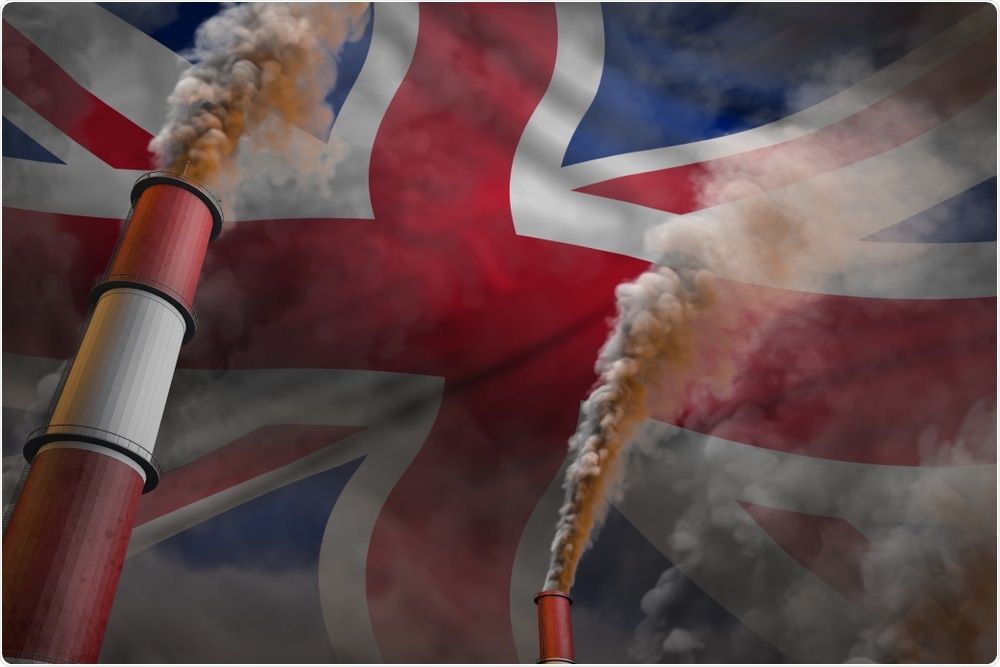A study by researchers from the Imperial College London provides specific evidence of an association between averaged exposure during 2014-2018 to nitrogen dioxide (NO2) and COVID-19 mortality, while the role of atmospheric particulate matter (PM2.5) remains much more controversial. The paper is currently available on the medRxiv* preprint server.

Long-term exposure to air-pollution and COVID-19 mortality in England: a hierarchical spatial analysis. Image Credit: Anton Medvedev / Shutterstock

 This news article was a review of a preliminary scientific report that had not undergone peer-review at the time of publication. Since its initial publication, the scientific report has now been peer reviewed and accepted for publication in a Scientific Journal. Links to the preliminary and peer-reviewed reports are available in the Sources section at the bottom of this article. View Sources
This news article was a review of a preliminary scientific report that had not undergone peer-review at the time of publication. Since its initial publication, the scientific report has now been peer reviewed and accepted for publication in a Scientific Journal. Links to the preliminary and peer-reviewed reports are available in the Sources section at the bottom of this article. View Sources
Amidst the rapid escalation of coronavirus disease (COVID-19) spread and deaths around the world, and notwithstanding all recommended precautions, questions are raised about hitherto unrecognized risk factors that can influence mortality rates.
Accordingly, recent studies suggested a potential link between long-term exposure to air-pollution and COVID-19 mortality. Still, due to their ecological design based on large spatial units, they often fail to consider the strong localized air-pollution patterns, which may potentially lead to inadequate confounding adjustment.
Consequently, a research group from the MRC Centre for Environment and Health and Department of Epidemiology and Biostatistics, School of Public Health, Imperial College London in London, United Kingdom, aimed to investigate the effect of long-term exposure to NO2 and PM2.5 on COVID-19 deaths up to June 30, 2020, in England with the use of high geographical resolution.
"We hypothesize that long-term exposure to these compounds worsens the prognosis of COVID-19 patients, as exposure to pollution can suppress early immune responses to the infection, leading to later increases in inflammation and as it can affect the onset of pre-existing conditions", claim study authors.
Quantifying the effect of air pollution
This research endeavor is the first nationwide study in England appraising the effect of long-term exposure to NO2 and PM2.5 during 2014-2018 on COVID-19 mortality at the Lower Layer Super Output Area level.
The authors included 38,573 COVID-19 deaths at the Lower Layer 8 Super Output Area level in England (n=32,844 small areas). Lower Layer Super Output Area (LSOA) is a geospatial statistical unit used in England and Wales to facilitate the reporting of small area statistics. Furthermore, they have retrieved averaged NO2 and PM2.5 concentration values during 2014-2018 from the Pollution Climate Mapping Model.

Population weighted exposure per LSOA.
In order to integrate information across many levels, Bayesian hierarchical models were utilized to quantify the effect of air pollution, while simultaneously adjusting for a series of confounding and spatial autocorrelation.
Finally, in a stringent post hoc analysis, the researchers have investigated whether the evidence of an effect of NO2 on COVID-19 mortality can be attributed to any pre-existing conditions. More specifically, diabetes, hypertension, and chronic obstructive pulmonary disease (COPD) were selected due to data availability and recent medical literature.
Robust spatial patterns
The resulting model indicates that for every 1μg/m3 increase in the long-term exposure to NO2 and PM2.5 the COVID-19 mortality rates rise for 0.5% and 1.4%, respectively – following the adjustment for the effect of confounding and spatial autocorrelation.
However, it has to be emphasized that this evidence is less robust for NO2, while for PM2.5 there is larger uncertainty. This corresponds to a posterior probability of a positive effect of 0.93 and 0.78, respectively.
Moreover, the spatial relative risk exhibited strong spatial patterns, basically identical for the different pollutants, which potentially captures the disease spread during the first wave of the COVID-19 pandemic.
In pursuit of stronger evidence
"Compared to the previous studies, our results are the smallest in magnitude, likely because of the high geographical precision that allows more accurate confounding and spatial autocorrelation adjustment," explain study authors in their medRxiv paper.
In addition, lack of power and individual exposure data may have also contributed to weak evidence of an effect. Since for NO2, the authors found a high posterior probability of a lethal outcome, they argued that a potential explanation might be the mediation effect of the aforementioned pre-existing conditions.
The analysis also captured strong spatial autocorrelation. Such a pattern could reflect residual variation from a possibly deficient covariate adjustment (including disease spread), spatial variation of pre-existing conditions, other unspecified spatial confounders, or a combination of those.
In conclusion, this study indeed provided some evidence that there is a link between average NO2 exposure and COVID-19 mortality; however, further studies are definitely needed to elucidate the exact role of PM2.5.

 This news article was a review of a preliminary scientific report that had not undergone peer-review at the time of publication. Since its initial publication, the scientific report has now been peer reviewed and accepted for publication in a Scientific Journal. Links to the preliminary and peer-reviewed reports are available in the Sources section at the bottom of this article. View Sources
This news article was a review of a preliminary scientific report that had not undergone peer-review at the time of publication. Since its initial publication, the scientific report has now been peer reviewed and accepted for publication in a Scientific Journal. Links to the preliminary and peer-reviewed reports are available in the Sources section at the bottom of this article. View Sources
Article Revisions
- Mar 29 2023 - The preprint preliminary research paper that this article was based upon was accepted for publication in a peer-reviewed Scientific Journal. This article was edited accordingly to include a link to the final peer-reviewed paper, now shown in the sources section.